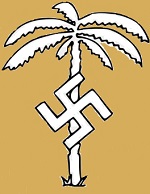Corgi CC60004 German Krauss-Maffei Sd. Kfz. 7 8-Ton Prime Mover/ Artillery Tractor - 21.Panzer Division, Deutsches Afrika Korps, Tripoli, Lybia, 1941 (1:50 Scale)
"If the tank succeeds, then victory follows."
- Major-General Heinz Guderian, "Achtung Panzer!"
 Development of the Sd. Kfz. 7 can be traced back to a 1934 requirement for an 8-ton half-track. The vehicle first appeared in 1938 and was destined to be used mainly as the tractor for the 8.8cm flak gun. The Sd. Kfz. 7 was an extremely useful vehicle, employed both as a weapons carrier and prime mover by the Wehrmacht. They also saw service as observation and command posts for V2 rocket batteries. The vehicle could carry up to 12 men and a considerable quantity of supplies, as well as pulling up to 8000kg (17,600 lbs) of equipment. Most were fitted with a winch, which enabled them to pull smaller disabled vehicles out of mud or other quagmires. A mainstay of the German Army, the Sd. Kfz. 7 was even admired by the enemies of the Reich. In fact, the British tried to make exact copies of captured Sd. Kfz. 7s and some vehicles were appropriated for use by the Allies after World War II.
Development of the Sd. Kfz. 7 can be traced back to a 1934 requirement for an 8-ton half-track. The vehicle first appeared in 1938 and was destined to be used mainly as the tractor for the 8.8cm flak gun. The Sd. Kfz. 7 was an extremely useful vehicle, employed both as a weapons carrier and prime mover by the Wehrmacht. They also saw service as observation and command posts for V2 rocket batteries. The vehicle could carry up to 12 men and a considerable quantity of supplies, as well as pulling up to 8000kg (17,600 lbs) of equipment. Most were fitted with a winch, which enabled them to pull smaller disabled vehicles out of mud or other quagmires. A mainstay of the German Army, the Sd. Kfz. 7 was even admired by the enemies of the Reich. In fact, the British tried to make exact copies of captured Sd. Kfz. 7s and some vehicles were appropriated for use by the Allies after World War II.
Pictured here is a 1:50 scale replica of a German Kraus-Maffei Sd. Kfz. 7 semi-tracked personnel carrier/prime mover used by the
Afrika Korps at Tripoli, Libya, in 1941. Sold Out!
Dimensions:
Length: 5-inches
Width: 2-inches
Release Date: October 2003
Historical Account: "Second Empire" - Mussolini's attempt to re-establish an African empire for Italy had, by late 1940, resulted in nearly total defeat at the hands of the British and the strong danger that Italy would be driven out of North Africa. Hitler was determined to maintain the Theatre of Operations forcing the British to keep men and resources in the desert and so was formed the famous military unit, Deutsches Afrikakorps. The rush to form an expeditionary forces and the fact that anew tropical scheme was yet to be finalized resulted in the first vehicles to arrive in North Africa still painted in an overall dark grey. In February 1941, these started to arrive as Rommel pushed for a swift attack against the British 8th Army and battle began immediately across the face of Libya.


